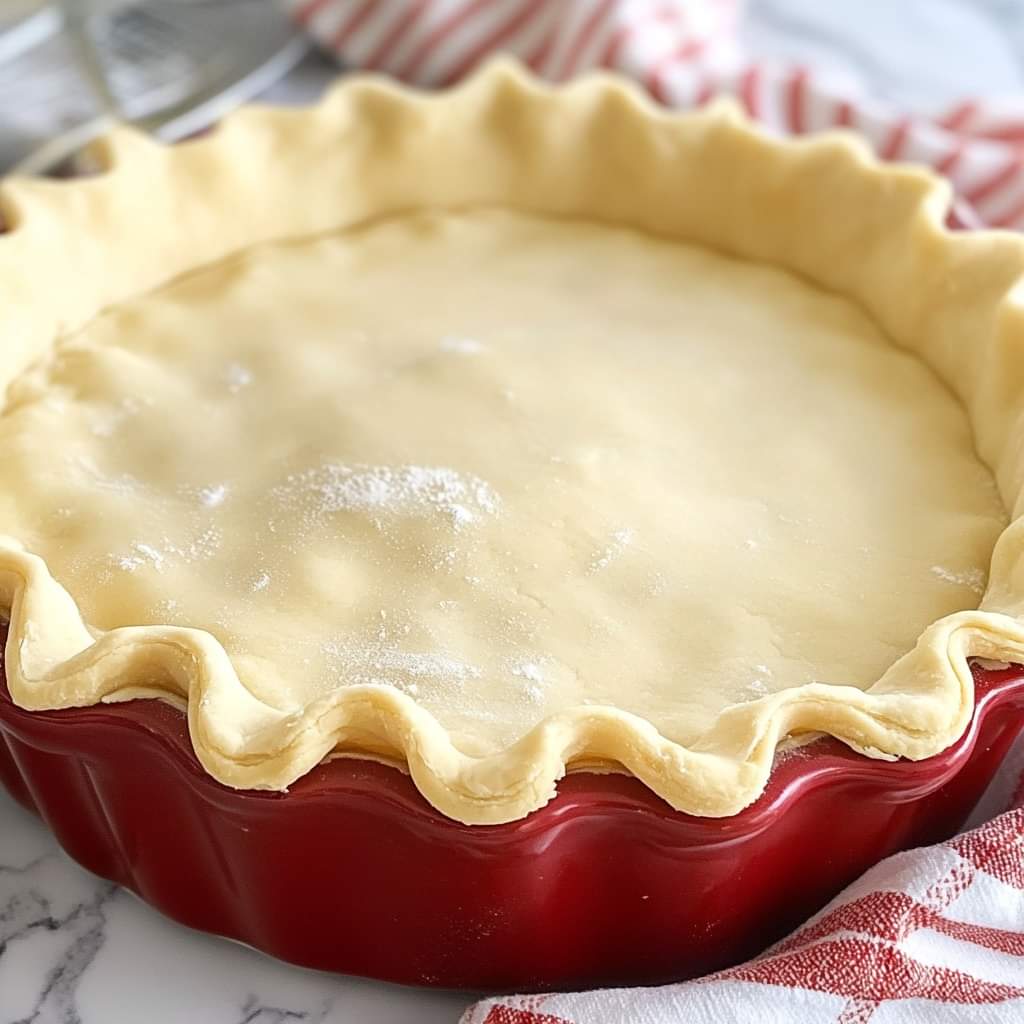This simple and reliable pie crust is buttery, flaky, and comes together quickly with just a few ingredients. Whether you’re making a fruit pie, quiche, or a savory tart, this crust will serve as the perfect base for both sweet and savory dishes. The key to a great pie crust is cold butter and minimal handling, which ensures a light, tender texture every time.
Origin and Cultural Significance:
Pie crusts have been a cornerstone of baking for centuries, dating back to ancient civilizations. In early European cuisine, pie crusts were referred to as “coffins” and were mainly used to encase and preserve the fillings inside, though they weren’t always eaten. Over time, pie crusts evolved into a delicacy themselves, especially in French pastry traditions where they became synonymous with elegance. Today, a well-made pie crust is a cherished part of many cultures and cuisines around the world, from sweet American apple pies to French savory tarts and quiches.
INGREDIENTS:
1 1/4 cups all-purpose flour
1/2 teaspoon salt
1 tablespoon sugar (optional, for sweet pies)
1/2 cup (1 stick) unsalted butter, very cold and cut into small cubes
3–4 tablespoons ice water
Optional Additions:
Vinegar or lemon juice (1 teaspoon): Helps tenderize the dough and prevent it from shrinking.
Herbs (for savory pies): Add chopped thyme, rosemary, or oregano for a flavorful crust.
Cheese (for savory pies): Grated Parmesan or cheddar can be incorporated into the dough for an extra layer of flavor.
Tips for Success:
Keep Everything Cold: Cold butter and ice water are key to creating a flaky crust. Work quickly to keep the butter from warming up.
Don’t Overwork the Dough: Minimal mixing ensures the butter stays in small chunks, which helps create pockets of flakiness when baked.
Chill the Dough: After mixing, refrigerate the dough for at least 30 minutes before rolling it out to relax the gluten and make it easier to handle.
Blind Baking for Wet Fillings: If using the crust for a custard-based filling (like quiche), blind-bake the crust by partially baking it before adding the filling.
INSTRUCTIONS:
Mix the dry ingredients: In a large bowl, whisk together the flour, salt, and sugar (if using).
Cut in the butter: Add the cold, cubed butter to the flour mixture. Using a pastry cutter or your fingers, quickly cut the butter into the flour until the mixture resembles coarse crumbs with some larger pea-sized pieces of butter remaining.
Add ice water: Drizzle in the ice water, one tablespoon at a time, and stir with a fork until the dough just begins to come together. The dough should hold together when pressed but should not be too wet or sticky.
Form the dough: Turn the dough out onto a lightly floured surface. Gently gather it into a ball, flatten it into a disc, wrap it in plastic wrap, and refrigerate for at least 30 minutes.
Roll out the dough: On a lightly floured surface, roll out the chilled dough into a 12-inch circle, about 1/8 inch thick. Carefully transfer it to a 9-inch pie plate.
Trim and crimp: Trim any excess dough, leaving about a 1/2-inch overhang. Fold the edges under and crimp them as desired.
Chill again: Place the prepared crust in the fridge for 15 minutes before filling or blind baking to ensure it maintains its shape during baking.
Bake (if blind baking): For recipes requiring a pre-baked crust, line the crust with parchment paper and fill it with pie weights or dried beans. Bake at 375°F (190°C) for 15–20 minutes, then remove the weights and parchment and bake for another 5–7 minutes until golden brown.
Description:
This pie crust is tender and flaky, with rich buttery layers that melt in your mouth. The balance of cold butter and minimal handling creates a texture that is both crisp and delicate, perfect for holding fillings without becoming soggy. Whether it’s a sweet apple pie or a savory quiche, this crust is versatile enough to complement any flavor profile, delivering both structure and flavor.
Nutritional Information (per serving, based on 8 servings):
Calories: 180
Fat: 12g
Saturated Fat: 7g
Carbohydrates: 15g
Protein: 2g
Sodium: 150mg
Fiber: 1g
Conclusion:
A great pie begins with a great crust, and this buttery, flaky pie crust is just that. Its versatility allows it to be used for a variety of dishes, from decadent desserts to hearty savory pies. By following simple techniques, you’ll achieve a crust that is both tender and flavorful, perfect for any occasion.
Recommendation:
For sweet pies, consider adding a little sugar to the dough for a subtle sweetness that enhances fruit or custard fillings. For savory pies, herbs or cheese can be added for a crust that pairs beautifully with quiches, tarts, or pot pies.
Embracing Healthful Indulgence:
While traditional pie crust is made with butter, you can lighten it up by substituting part of the butter with a healthier fat, such as olive oil or a plant-based alternative. Whole wheat flour can also be used to increase the fiber content. By practicing portion control and serving alongside nutrient-rich sides like fresh fruit or salads, you can enjoy this i
ndulgent treat while maintaining a balanced diet.
